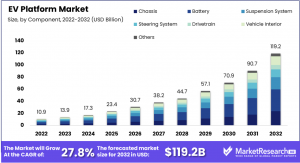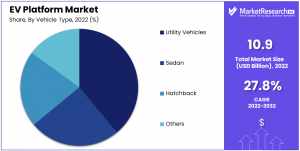EV Platform Market size is expected to be worth around USD 119.2 Bn by 2032 from USD 10.9 Bn in 2022, growing at a CAGR of 27.8%
NEW YORK, NY, UNITED STATES, January 29, 2025 /EINPresswire.com/ — Market Overview
EV Platform Market size is expected to be worth around USD 119.2 Bn by 2032 from USD 10.9 Bn in 2022, growing at a CAGR of 27.8% during the forecast period from 2023 to 2032.
The EV (Electric Vehicle) Platform Market refers to the segment of the automotive industry focused on developing and manufacturing the foundational platforms upon which electric vehicles are built. These platforms typically include the battery packs, powertrains, and essential structural elements that make electric vehicles functional. They serve as the "base" or "architecture" that supports various types of electric vehicles, including cars, trucks, and buses, enabling automakers to create different models with varying features and capabilities. The EV platform market is a critical component in the transition towards sustainable and environmentally friendly transportation solutions.
The EV Platform Market is experiencing robust growth driven by the global shift towards sustainability and decarbonization of the transportation sector. The increasing demand for electric vehicles, both from consumers and governments, is reshaping the automotive landscape. Automakers are investing heavily in dedicated electric vehicle platforms that can support a wide range of models, providing flexibility and scalability in their production lines. This demand is also spurred by advancements in battery technology, powertrain efficiency, and the need for lower manufacturing costs. With technological innovations accelerating, the development of versatile EV platforms is expected to be a key differentiator among market leaders.
The growth of the EV Platform Market is closely tied to government initiatives and regulations aimed at reducing carbon emissions. Several countries have introduced policies that not only encourage the adoption of electric vehicles but also incentivize the development of EV infrastructure and platforms. These regulations, such as stricter fuel efficiency standards and emission reduction targets, are propelling automotive manufacturers to shift from internal combustion engines to electric platforms. Moreover, government investments in EV-related technologies and charging infrastructure further bolster the growth of the market. With increasing global emphasis on clean energy and carbon neutrality, we can expect this market to expand rapidly, driven by both public and private sector collaboration.
For both new entrants and established players, the EV platform market presents significant opportunities for growth. Existing automakers can leverage their experience in vehicle manufacturing while transitioning to electric platforms, gaining a competitive edge by offering a broader portfolio of electric models. For new players, the market provides an avenue to innovate and create specialized platforms catering to niche segments such as commercial electric vehicles, autonomous driving platforms, or affordable electric cars. Strategic partnerships, including collaborations with tech firms and battery manufacturers, can further strengthen their position in this fast-growing market. The increasing demand for more efficient, scalable, and flexible EV platforms presents ample opportunities for market expansion.
Curious About Market Trends? Request Your Complimentary Sample Report Today: https://marketresearch.biz/report/ev-platform-market/request-sample/
Key Takeaway
–The EV Platform Market was valued at USD 10.9 billion in 2022 and is expected to reach USD 119.2 billion by 2032, growing at a CAGR of 27.8% from 2023 to 2032.
–Battery systems hold the largest share in the market, driven by continuous advancements in battery technology, extended range, and lower production costs.
–Battery Electric Vehicles (BEVs) dominate over Hybrid Electric Vehicles (HEVs), as automakers shift towards fully electric platforms with long-term sustainability goals.
–Utility vehicles (SUVs) are leading the market, as consumer preferences in major markets like China and the U.S. shift from sedans to spacious, high-performance EVs.
–Asia-Pacific is expected to lead the market, driven by aggressive EV adoption, government incentives, and investments in charging infrastructure, particularly in China, Japan, and South Korea.
Use Cases
Electric Vehicle Production Expansion
The growing demand for electric vehicles (EVs) has led automakers to adopt scalable EV platforms that allow for the efficient production of various vehicle types, including sedans, SUVs, and trucks. These platforms reduce production costs, shorten development times, and streamline manufacturing processes, making EVs more accessible to a broader market.
Battery Integration and Range Optimization
EV platforms are designed to integrate high-performance batteries that enhance driving range, one of the primary concerns of consumers considering EVs. Manufacturers are incorporating advanced battery management systems into their platforms, improving energy efficiency and increasing the overall range of electric vehicles, which is vital for consumer adoption.
Flexible Manufacturing for Different Market Segments
Many EV platform developers focus on creating flexible architectures that can be customized for different market segments. This flexibility allows manufacturers to produce various models from a single platform, reducing costs and enabling automakers to offer electric vehicles at different price points, appealing to a wide range of consumers.
Autonomous Driving Integration
EV platforms are increasingly being designed to support autonomous driving technologies. By integrating sensors, AI, and advanced computing systems, these platforms provide the necessary foundation for self-driving capabilities. As autonomous driving technologies advance, the demand for EV platforms that support these features will continue to grow, driving further market expansion.
Sustainability and Recycling Integration
EV platforms are incorporating eco-friendly materials and sustainable manufacturing practices, which aligns with the broader goals of reducing carbon footprints. Additionally, these platforms support easy recycling of key components, such as batteries and materials used in the body, helping manufacturers meet environmental standards and appeal to eco-conscious consumers.
Driving Factors
Rising Demand for Electric Vehicles: The increasing global demand for electric vehicles (EVs) is the primary driver of the EV platform market. As more consumers shift towards electric mobility due to environmental concerns and government incentives, the demand for EV platforms (the underlying architecture for electric vehicles) continues to rise.
Government Regulations and Incentives: Governments are setting ambitious targets for reducing carbon emissions, including the widespread adoption of electric vehicles. Tax incentives, subsidies, and stricter emission standards are encouraging automakers to invest in EV platforms, accelerating the growth of the market.
Advancements in Battery Technology: Improvements in battery technology, including higher energy density, lower costs, and faster charging times, are making electric vehicles more accessible and efficient. As battery performance improves, the need for advanced EV platforms designed to accommodate these technologies grows, driving market demand.
Automaker Transition to Electric Vehicles: Many major automakers are transitioning their fleets to electric models, often leveraging shared or modular EV platforms to reduce development costs. These platforms allow manufacturers to design multiple EV models on the same base architecture, promoting economies of scale and accelerating EV adoption.
Sustainability and Environmental Awareness: As consumers become more environmentally conscious, the demand for electric vehicles and, consequently, EV platforms is rising. The push for sustainable transportation solutions, combined with a reduction in greenhouse gas emissions, is a strong driver for the EV platform market.
Report Segmentation
By Component
• Chassis
• Battery
• Suspension System
• Steering System
• Drivetrain
• Vehicle Interior
• Others
By Electric Vehicle Type
• Battery Electric Vehicle
• Hybrid Electric Vehicle
By Vehicle Type
• Hatchback
• Sedan
• Utility Vehicles
• Others
Ready to Act on Market Opportunities? Buy Your Report Now and Get 30% off: https://marketresearch.biz/purchase-report/?report_id=41721
Regional Analysis
The global EV platform market is dominated by North America, Europe, APAC, Latin America, and the Middle East & Africa. However, APAC and Europe are experiencing rapid EV adoption, fueled by heavy investments in research and development (R&D) and strong government support for electrification.
Europe, in particular, is seeing accelerated EV penetration, driven by stringent emission regulations, incentives for EV buyers, and the expansion of charging infrastructure. Similarly, APAC countries like China, Japan, and South Korea are leading in EV production and battery innovation, further strengthening the region’s market presence.
As demand for electric vehicles continues to rise, the EV platform market is expected to witness significant growth, with technological advancements, battery efficiency improvements, and automaker investments playing a crucial role in shaping the industry’s future.
Growth Opportunities
Growing Demand for Electric Vehicles (EVs): With increasing consumer interest in sustainable transportation, the demand for electric vehicles is on the rise. The EV platform market presents an opportunity for businesses to develop and supply the essential infrastructure and technology required to support these vehicles.
Government Incentives and Regulations: Many governments are offering incentives for electric vehicle adoption, such as tax credits and rebates. This, combined with stricter emissions regulations, creates a growing need for EV platforms to support the infrastructure development, such as charging stations and battery management systems.
Technological Advancements in EV Charging: The demand for faster, more efficient EV charging solutions is growing. Developing advanced charging technologies, such as ultra-fast charging or wireless charging, offers businesses the chance to lead the market by offering cutting-edge solutions to EV owners.
Expansion of EV Charging Infrastructure: As the number of electric vehicles increases, the need for widespread charging infrastructure grows. Companies can capitalize on this by investing in and expanding EV charging networks, offering both public and private charging stations to meet growing demand.
Partnerships with Automakers: Partnerships between EV platform providers and automakers can drive growth by integrating platform solutions directly into electric vehicles. This collaboration can result in optimized performance and an enhanced user experience for EV owners, creating new opportunities for businesses in this space.
Key Players
• Alcraft Motor Company
• Baic Motor
• BMW
• BYD
• Byton
• Canoo
• Chery
• Daimler
• Faraday Future
• Fisker
• Ford
• Geely
• General Motors
• Honda
• Hyundai
• JAC
• Kia Motors
• Nissan Motor
• Open Motors
• REE Auto
• Rivian
• Saic Motor
• Toyota
• Volkswagen
• Volvo
• XAOS Motors
• Zotye
Not Sure? Request a Sample Report and See How Our Insights Can Drive Your Business: https://marketresearch.biz/report/ev-platform-market/request-sample/
Conclusion
In conclusion, the markets analyzed are all experiencing growth driven by evolving consumer preferences, technological advancements, and increasing demand for customized, high-quality products. Key trends, such as the adoption of sustainable practices, integration of smart technologies, and rising disposable incomes, are shaping the competitive landscape. While challenges such as market saturation, price sensitivity, and regional differences persist, opportunities abound for companies to capitalize on niche segments, leverage digital platforms, and innovate to meet the specific needs of their target audiences. As these industries continue to expand, businesses that adapt to changing trends, prioritize customer-centric strategies, and invest in innovation will be well-positioned for long-term success.
Related Report
Train Seat Market: https://marketresearch.biz/report/train-seat-market/
Tower Crane Market: https://marketresearch.biz/report/tower-crane-market/
Aircraft Exhaust System Market: https://marketresearch.biz/report/aircraft-exhaust-system-market/
Wireless Electric Vehicle Charging Market: https://marketresearch.biz/report/wireless-electric-vehicle-charging-market/
Road Rail Vehicles Market: https://marketresearch.biz/report/road-rail-vehicles-market/
Lawrence John
Prudour
+91 91308 55334
Lawrence@prudour.com
Legal Disclaimer:
EIN Presswire provides this news content “as is” without warranty of any kind. We do not accept any responsibility or liability
for the accuracy, content, images, videos, licenses, completeness, legality, or reliability of the information contained in this
article. If you have any complaints or copyright issues related to this article, kindly contact the author above.
![]()



